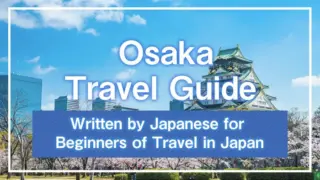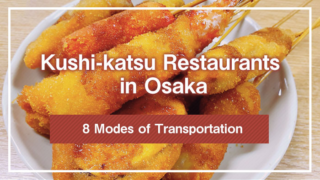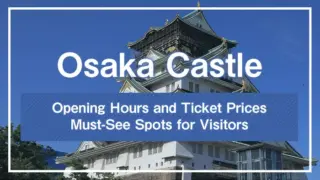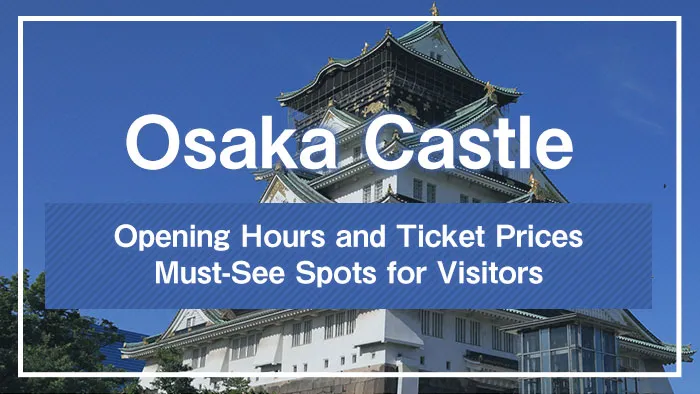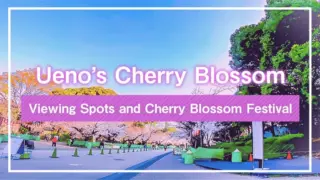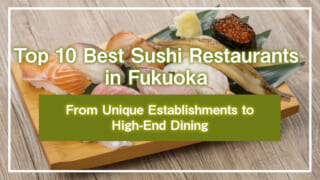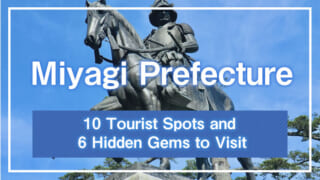Osaka Castle, constructed in 1583 by Toyotomi Hideyoshi, is a historic edifice in Osaka and a perfect tourist spot for those wanting to understand Japanese history. The grounds also serve as a park, featuring gardens where beautiful cherry and peach blossoms bloom.
This guide covers everything from how to access Osaka Castle, its opening hours and fees, to the must-see spots within the park. We highly recommend foreign tourists visiting Osaka to read this guide.
1.About Osaka Castle
Osaka Castle is located in the heart of Osaka Prefecture and was constructed by Toyotomi Hideyoshi in 1583. After its initial construction, it went through several periods of destruction, burning, and reconstruction. The Osaka Castle which visitors can see today was rebuilt in 1928 based on the original structure built by Hideyoshi. Although Osaka suffered significant damage during World War II, Osaka Castle remained intact, and extensive renovations were carried out from 1995 to 1997.
The interior of the castle’s main tower now serves as a museum, displaying valuable documents and crafts. Additionally, there’s an observation deck on the top floor that offers panoramic views of the beautiful Osaka landscape.
Osaka Castle Park, which surrounds Osaka Castle, retains many historical sites from the original castle, including thirteen buildings designated by the government as Important Cultural Properties. Surrounded by beautiful nature, the park provides a pleasant place for a walk.Taking a tour boat around the moat is another of the park’s charming attractions.
2.Osaka Castle’s Opening Hours and Fees
Osaka Castle Park is accessible at any time. However, the hours of entry for Osaka Castle’s main tower and the Nishinomaru Garden are as follows:
| Osaka Castle Main Tower | 9:00 AM to 5:00 PM (entry until 4:30 PM)*1 *2 |
|---|---|
| Nishinomaru Garden | 9:00 AM to 5:00 PM (March to October) 9:00 AM to 4:30 PM (November to February)*3 *4 |
| Osaka Castle Park | Accessible 24 hours |
*1: Closed from December 28th to January 1st.
*2: During the cherry blossom season, Golden Week, and summer holidays, the opening hours are extended by about an hour.
*3: Closed on Mondays (or the next day if Monday is a national holiday), and during the New Year holidays from December 28th to January 4th.
*4: Opening hours change during the cherry blossom season.
source:大阪城天守閣「ご利用案内」
source:大阪城公園「よくある質問」
source:大阪城公園「西の丸庭園」
The main tower is open from 9:00 AM to 5:00 PM, but entry is not permitted after 4:30 PM. Opening hours are extended during the cherry blossom season, Golden Week, and summer vacation.
The Nishinomaru Garden, located to the west of the main tower, shortens its operating hours in the winter. It is closed on Mondays and during the New Year holiday period (December 28th to January 4th).
Admission fees for the main tower and Nishinomaru Garden are as follows:
・Fees for facilities within Osaka Castle Park:
| Osaka Castle Main Tower | 600 yen*1 (Free for junior high school students and younger) |
|---|---|
| Nishinomaru Garden | Nishinomaru Garden: 200 yen*2 (Free for junior high school students and younge) |
| Osaka Castle Park | Free |
| Osaka Museum of History (Permanent Exhibition) + Osaka Castle Main Tower | Set ticket for 1,000 yen |
| Osaka Water Bus + Osaka Castle Main Tower | Set ticket for 2,000 yen*3 |
*1: From 2025, the price will increase to 1,200 yen for adults, and 600 yen for high school and college students.
*2: Admission fees change during the cherry blossom season.
*3: Not sold from late March to mid-April.
source:大阪城天守閣「ご利用案内」
source:大阪城公園「よくある質問」
source:大阪城公園「西の丸庭園」
The admission fee for the main tower is 600 yen for adults until 2024, but it is scheduled to increase to 1,200 yen for adults and 600 yen for high school and college students from 2025. Entry is free for junior high school students and younger, but proof of age, such as a student ID, will be required.
The entry fee for Nishinomaru Park is 200 yen, with free admission for junior high school students and younger, and for those with disabilities. However, documentation proving eligibility is required. Additionally, admission fees may change during the cherry blossom season.
The set ticket for the Osaka Museum of History and Osaka Castle’s main tower is 1,000 yen. The Osaka Museum of History is built on the site of the former Osaka City Museum within Osaka Castle Park, and its permanent exhibition features recreations of Osaka’s history from ancient times to the modern era.
The set ticket for the Osaka Water Bus and the main tower is 2,000 yen. The Osaka Water Bus offers a tour around Okawa River, the central river flowing through Osaka, allowing passengers to enjoy the cityscape.
2-1.Access to Osaka Castle
The address of Osaka Castle is “1-1, Osaka-jo, Chuo-ku, Osaka City”.
Osaka Castle is centrally located in Osaka Prefecture, making it easily accessible. Multiple train lines are available, including the subway, JR, and Keihan Railway, all of which have stations close by. Here, we will introduce each line and its nearest stations. If you’re taking the subway, please also pay attention to the exit numbers.
Using the Subway (Osaka Metro)
○Tanimachi Line
-“Tanimachi 4-chome Station” Exit 1-B
-“Temmabashi Station” Exit 3
○Chuo Line
-“Tanimachi 4-chome Station” Exit 9
-“Morinomiya Station” Exit 1 & Exit 3-B
○Nagahori Tsurumi-ryokuchi Line
-“Morinomiya Station” Exit 3-B
-“Osaka Business Park Station” Exit 1
Using JR
○Osaka Loop Line
-Morinomiya Station
-Osakajokoen Station
○Tozai Line
-Osakajo-kitazume Station
Using Keihan Railway
-Temmabashi Station
The estimated time from each station to Osaka Castle Park is about 10 to 15 minutes on foot.
If you’re using the city bus, take bus number 62 from in front of Osaka Station and get off at “Osakajo Otemon” or “Babacho”.
3.Must-See Spots in Osaka Castle Park
Osaka Castle Park is spacious and filled with worthwhile spots to visit. When visiting Osaka Castle, we recommend touring the attractions within the park. Here, we will introduce a few places especially recommended for tourists from overseas.
3-1.The Main Tower of Osaka Castle
Osaka Castle’s eight -story main tower is its core architectural element, serving not only as a watch tower to survey the surroundings but also as a storage place for weapons. It is renowned for its balanced and imposing appearance. It is now open to the public as a history museum.
From the first to the seventh floor, there are exhibition areas where visitors can see valuable artifacts related to Toyotomi Hideyoshi, the builder of Osaka Castle, and the Sengoku period in which he lived. Fascinating exhibits such as the Summer War of Osaka folding screens, actual helmets and armor, dioramas, and panorama scenes ensure that visitors are never bored.
From the observation deck on the eighth floor, visitors can enjoy panoramic views of Osaka Castle Park and the surrounding area. There is also a souvenir shop on the first floor, where picking out Osaka Castle goods can make for a memorable experience.
3-2.Nishinomaru Garden
The Nishinomaru Garden, located on the west side of Osaka Castle, covers an expansive area of about 6.5 hectares. Over half of the garden is a lawn planted with about 300 cherry trees, which are beautifully illuminated during events in the spring. A visit to Nishinomaru Garden is recommended if you’re visiting Osaka Castle Park in spring.
The garden also has a guest house built in 1995 to entertain world leaders for an unofficial summit. Opposite the guest house, there is a rest area where visitors can take a break from walking.
In addition, the garden contains several important cultural properties, including the Senkoku-yagura, Kinmeisui well, and the Hōnō storehouse. The Senkoku-yagura and Kinmeisui were built for monitoring and attacking invaders to the castle, while the Hōnō storehouse was used as a gunpowder magazine.
source:OSAKAINFO「大阪城西の丸庭園」
3-3.The Plum Grove
On the east side of Osaka Castle Park, there is a plum grove that spans approximately 1.7 hectares and is planted with over 100 varieties of around 1,000 plum trees. The plum trees start blooming with beautiful flowers from mid-January, and by February the area becomes a beautiful sight with red, pink, and white flowers blooming all over. If you’re planning to visit Osaka Castle Park around February, the plum grove is also worth visiting. Admission is free.
During the plum blossom season, a convenience store named “Plum Grove Lawson” opens. Enjoying warm food and drinks while viewing the plums blooming in the cold season is also recommended.
source:特別史跡大阪城公園「梅林」
3-4.MIRAIZA Osaka-Jo
MIRAIZA Osaka-Jo is a facility located in front of the main tower where you can enjoy shopping and dining. This facility utilizes a building constructed in 1931 for the army and contains shops, cafes, and restaurants. Here, you can buy souvenirs, and takeout food and drinks are available.
In the basement, there is a figure museum operated by Kaiyodo, an Osaka City-based model production company whose achievements include supplying exhibits to the American Museum of Natural History. The museum displays over 3,000 figures across ten categories, and in the museum shop you can purchase figures, goods, and souvenirs.
The admission fee for the figure museum is 1,000 yen for adults (high school students and older) and 500 yen for children (elementary and junior high school students).
source:OSAKAINFO「ミライザ大阪城」
Summary
Osaka Castle’s main tower and the surrounding Osaka Castle Park are must-see spots for foreign tourists visiting Japan. The main tower is open from 9:00 to 17:00 (with last entry at 16:30), and the admission fee is 600 yen for adults (which will increase to 1,200 yen for adults and remain 600 yen for high school and university students from 2025). Admission to Osaka Castle Park is free, and visitors can freely stroll around from early morning until late at night.
Tourists can experience the grandeur of this historic castle built by Toyotomi Hideyoshi, and in spring, enjoy nature with plum and cherry blossoms in the plum grove and Nishinomaru Garden. In particular, the inside of the main tower, with its turrets, castle walls, moats, and numerous exhibits, is an excellent place to deepen one’s knowledge of Osaka’s history and culture.
*This article is based on information available as of March 2024.

